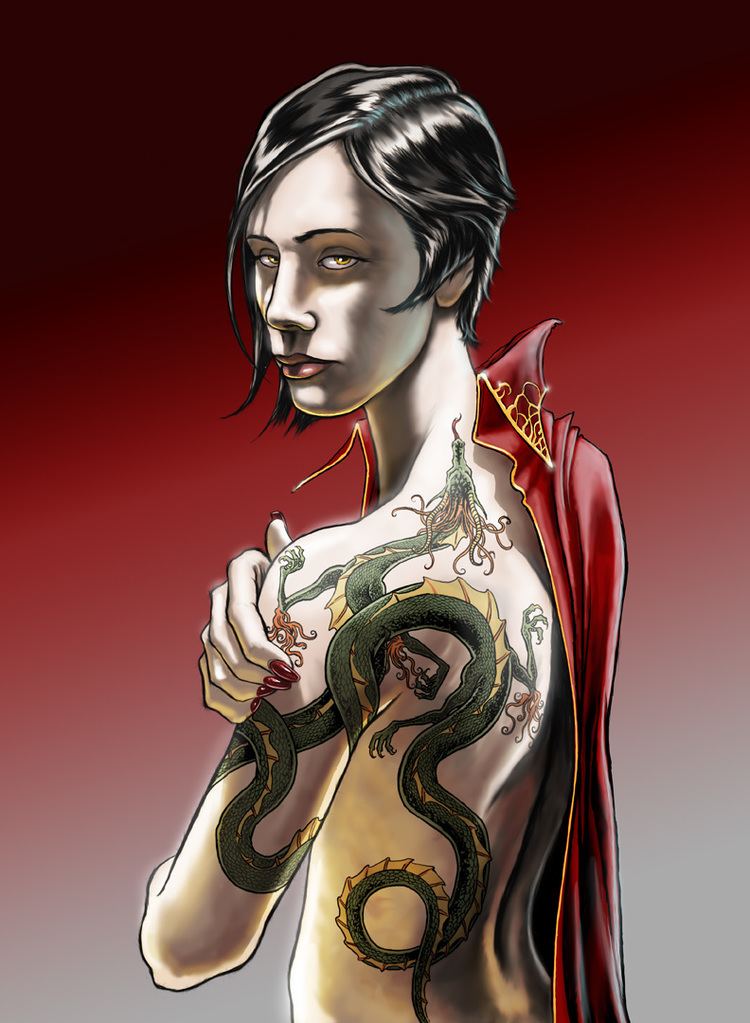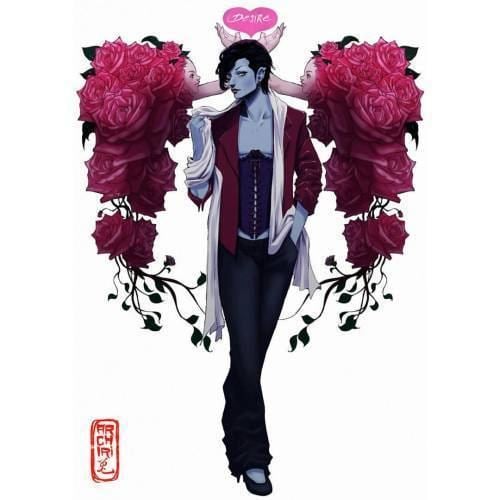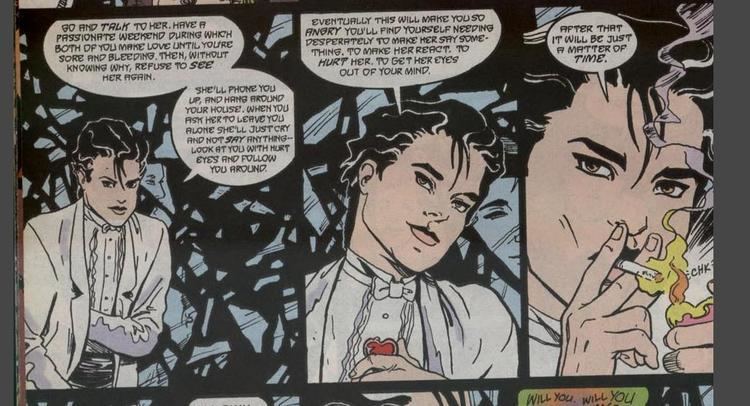Publisher DC Comics Affiliation Endless | Team affiliations The Endless | |
 | ||
Created by Neil Gaiman
Mike Dringenberg Notable aliases Sister-Brother, Epithumia Abilities aspect of desire and fulfillment First appearance The Sandman #1 (October 1989) Creators Mike Dringenberg, Neil Gaiman Similar Despair, Delirium, Destiny, Destruction, Dream | ||
Desire is a fictional character from the DC comic book series The Sandman (1988–1996). The character, one of the Endless, first appeared in The Sandman vol. 2, #1 (November 1989), and was created by Neil Gaiman and Mike Dringenberg.
Contents

Publication history

Desire is first featured in the second issue of The Doll's House (the second trade paperback collecting The Sandman series). Gaiman claims to have drawn inspiration for Desire from "the sexy, androgynous" prints created by Patrick Nagel in the 1980s, and Annie Lennox circa 1987 while she was a member of Eurythmics. Dringenberg recalls differences he and Gaiman had in their view of Desire's visual appearance. While Gaiman saw Desire as being somewhere between David Bowie and Annie Lennox, Dringenberg saw them more in terms of Duran Duran (what he describes as "sort of two-dimensional and slightly vapid"). Dringenberg also cites his then girlfriend as being a visual inspiration for Desire; rendering the character in her likeness but with very short hair. Dringenberg points out the primary difference between their vision for Desire being that Gaiman's idea for the character was essentially sexless and unsatisfying. Dringenberg, on the other hand, saw it as being omni-sexual and perennially tempting. According to Dringenberg, his vision calls for a Desire with breasts and a bulge between its legs, and Gaiman's calls for nothing. Gaiman agrees with Dringenberg's view by explaining that Desire had to be made both male and female, because the character represents everything someone might desire. He adds that Desire being both male and female (or neither male nor female) provides symmetry to the Endless family: three males (Destiny, Dream, and Destruction), three females (Death, Despair, and Delirium), and Desire.

Todd Klein was asked to develop unique lettering styles for many of the main characters featured in The Sandman series. When he designed the typeface used for Desire's lettering, he rendered the letters in the style of Art Nouveau posters and ads to correspond with its Patrick Nagel visuals.

When Desire is first introduced in The Doll's House, it is shown within the Threshold: a giant, flesh and blood replica of itself which it calls home. Gaiman admits that he stole the name for the Threshold from a story Clive Barker had been planning to do in which Gaiman was going to be included as a character. He liked the name because threshold contains hold, meaning home or fortress. The idea for Desire living in its own body came from Gaiman deciding that desire lives under the skin. The conclusion of The Doll's House culminates in a confrontation between Dream and Desire. The reader has learned that Desire rapes Unity Kinkaid as part of a plot to ensnare its brother Dream. During an interview, Hy Bender asks Gaiman why Desire sleeping with a mortal woman isn't against a rule in DC continuity stating that the Endless aren't allowed to mate with mortals. Gaiman corrects him by pointing out that the rule is that the Endless cannot love mortals, and that rape is something altogether different. He goes on to point out that these plot devices help set up the Dream versus Desire conflict that spans The Sandman series. Bender also asks Gaiman about Desire appearing as an antagonist in The Sandman. Gaiman explains that Desire's role as a "villain" is due to its personality conflict with Dream. With Dream being the main character of the series, Desire was shortchanged. He goes on to say that if he were to write Desire Comics, that readers would have seen Dream in more of an antagonist role.

Desire's appearances are largely relegated to The Sandman series and related works. Desire also makes cameo appearances in Winter's Edge #1 and #3, a holiday title published by Vertigo.
Fictional character biography
Desire is the third youngest of the Endless and the twin of Despair. It is a strikingly beautiful figure whose gender is mutable, becoming male, female, both, or neither as the situation warrants. It is often referred to as "sibling" by its brethren, particularly Dream. Desire blends in effortlessly with whatever environment it finds itself in. It lives in the heart of a massive flesh-and-blood statue of itself, known as the Threshold. Indeed, further strengthening the connection to hearts, Desire's sigil in the galleries of the other Endless is a heart of cut glass.
Desire is described as being of medium height, smelling faintly of summer peaches. Desire casts two shadows, one black and sharp, the other translucent and wavering. Desire's smiles are brief and sharp. Its skin is "pale as smoke," and its eyes are "tawny and sharp as yellow wine."
Desire is easily the cruelest of the Endless. It seems obsessed with interfering with the affairs of its elder siblings, particularly Dream. The motivation behind this is not clear.
A story in Endless Nights, set long before any other Sandman story, explains the origins of the Desire/Dream enmity, and reveals that before this Desire was Dream's favorite sibling. Dream had fallen in love with a mortal, Killalla of the Glow, and had taken her to a gathering of stars (literally the embodiments of various suns). While there, Killalla met and fell in love with the star of her own home world, abandoning Dream. Desire's role in this is never made clear (except that love is obviously a form of desire). After introducing his lover to Desire when it first arrives, and leaving the two alone, Killalla asked what Desire had done for Dream to make him so affectionate, but Desire indicated that it hadn't done anything at all. Later, however, when Dream angrily blames Desire for the whole affair, Desire offers no defense, only asking Destruction after Morpheus storms off, "Doesn't he have a sense of humor?" This story, set billions of years before the story-arc of The Sandman, tends to portray the characters in a very different light, showing that even the Endless are not unchanging, with Desire's attitude towards Dream being playful rather than malicious during this early encounter.
The enmity between Dream and Desire continued through the millennia, eventually culminating in Desire raping and fathering a child on Unity Kinkaid, then attempting to have Dream kill Rose Walker, Unity's grandchild, which would have caused the ruthless and relentless Furies to hound Dream until he died for the crime of shedding family blood. When Dream discovered this at the end of The Doll's House, he openly threatened Desire with what would happen should Desire interfere in Dream's life again, and there was an uneasy truce between the two afterwards.
In The Sandman: Overture, Dream is forced to save the universe from the result of a dream vortex he failed to destroy. Along the way he is helped by an aspect of himself in the form of a giant cat. The cat is later revealed to be Desire in disguise, as Desire knew Dream would only accept help from himself. The result of the universe's restoration causes Desire to forget that it helped Dream.
In other media
Tori Amos, a well-known friend of Gaiman's, included a song titled "Sister Named Desire" as a B-Side for her single "Talula". The song was rerecorded for a tribute album to Gaiman that was assembled by the Dancing Ferret entertainment group titled Where's Neil When You Need Him? (named after a line from Amos' song "Space Dog").
